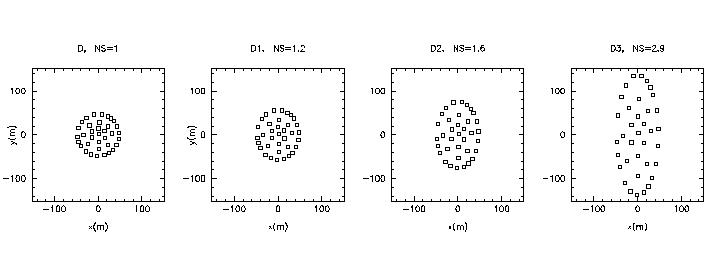 MMA Extended D Array Options Studied.
MMA Extended D Array Options Studied.Minutes for meeting Mon, 2 November 1998 at 11am ET.
Date: Monday, 2 November, 1998
Time: 11:00 am EST (9:00 am Socorro, 9:00 am Tucson)
Phone: (804)296-7082 (CV SoundStation Premier Conference phone).
Past minutes, etc on MMA Imaging and Calibration Division Page
Agenda
--------
-------- Configuration studies: Imaging (Helfer)
Investigations of N-S elongated arrays were presented. These are essentially the D array stretched out into D1, D2, and D3 configurations with many shared stations.
 MMA Extended D Array Options Studied.
MMA Extended D Array Options Studied.
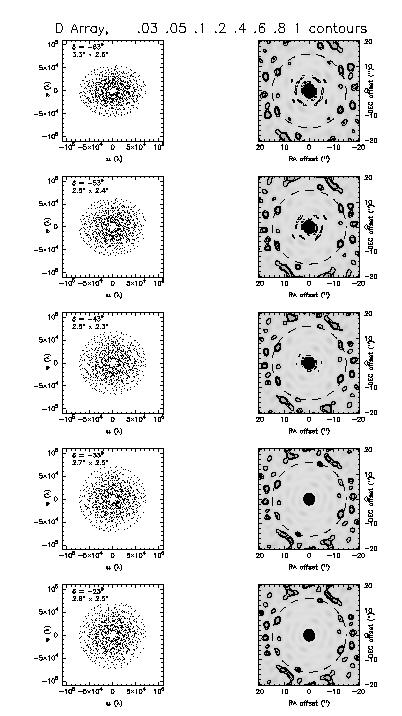 MMA Basic D Array Option Studied.
MMA Basic D Array Option Studied.
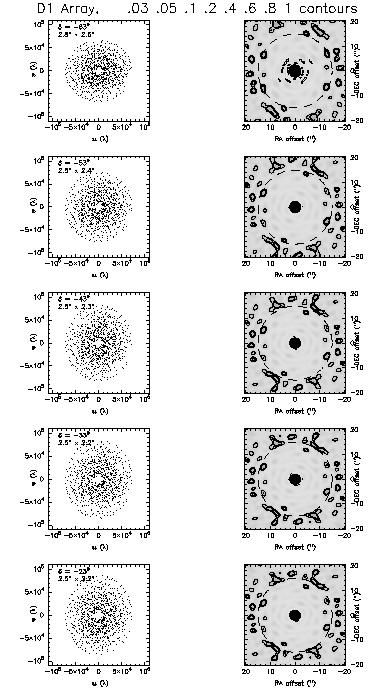 MMA ExtendedD1 Array Option Studied.
MMA ExtendedD1 Array Option Studied.
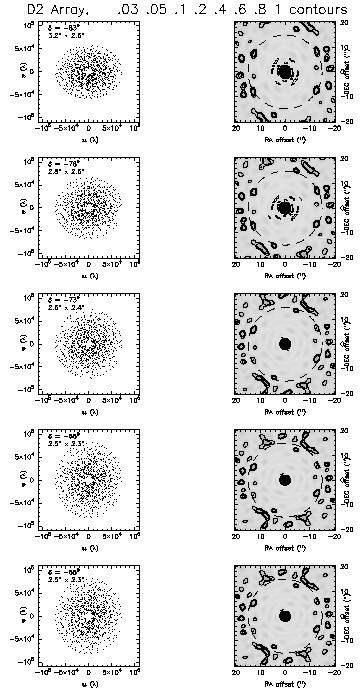 MMA ExtendedD2 Array Option Studied.
MMA ExtendedD2 Array Option Studied.
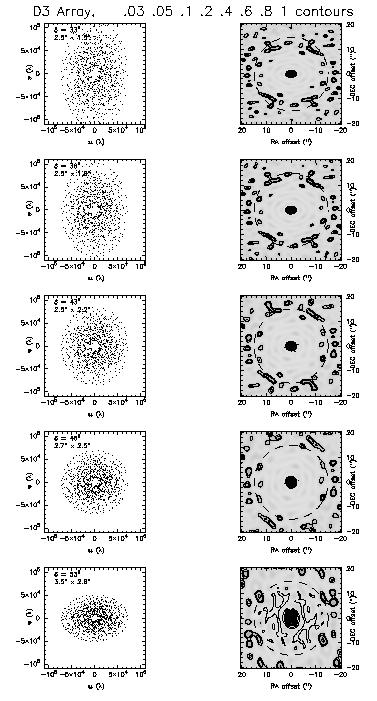 MMA ExtendedD3 Array Option Studied.
MMA ExtendedD3 Array Option Studied.
Holdaway pointed out that in his opinion, this is a minimum number (4) of configurations for D array without compromise to image quality owing to lack of short spacings, sensitivity owing to lack of shadowed antennas, and without compromising sidelobe performance. Since one configuration addresses a minimal area of sky, these four were reduced to three. See memo 155. Holdaway & Foster (1996) studied the shadowing limitations of a close-packed array and concluded that a set of four compact arrays could reasonably cover all elevations down to 10 degrees with a minimum of shadowing. Since their most stretched D4 configuration is useful for only about 4 percent of the sky, we can probably compromise the other arrays slightly and cover the D array requirements with three compact arrays. The D1 array, with a North-South elongation of 1.2, would cover zenith observations down to somewhat below the shadowing limit of 50; the D2 and D3 would be progressively more elongated, with elongations of about 2 and 3. These three arrays would cover the range of declinations available from the Chajnantor site, or -90 55.
Kogan suggested that it was time to move from beam images to images of simulated data, with noise added. He suggested using AIPS tasks in a convenient way for further modeling. This is also of interest for the VLA upgrade. Helfer pointed out that SDE already incorporates this functionality in a way more directly useful to MMA studies. It was decided that both approaches would be useful.
-------- Antenna Size Meeting 4 Nov
See comments by Dave Woody , Jack Welch , Jeff Mangum , Al Wootten . Last year's US MMA Science report and European report are also available. Attendees leave 3 November for this meeting, so anyone wishing to provide input should produce it.
-------- Radiosonde results (Butler, Radford)
Several radiosonde launches have provided data . Bryan and Simon have had a first crack at analysis. There is a fair amount of structured wind on the site, basically with the jet stream frequently very close to the ground, and little surface buffer zone, possibly a factor in the site dryness. The radiosondes provide no information on turbulence or wind direction. Radford reminds us that the latter is westerly all the time in winter, 60% of the time in summer. There may be more of a boundary layer in the summer, when air from the Bolivian/Argentine regions dominates. The hygrometer on the radiosondes underestimates the true water content of the atmosphere. In conjunction with the tipping radiometers, particularly at 350 microns and 183 GHz, and atmospheric models, we hope to get the quantity of water and its vertical distribution understood. Limits on the accuracy of this include the radiosonde instruments, the models (the Liebe 85 and Grossman models disagree on submillimeter opacity), and the tipping data. However, we know that during the first campaign at least, the water was distributed in 2-3 layers. A lower layer includes clouds, and a middle and upper layer are also present. Perhaps 25% of the total water is in the upper layer, with the rest in the lower layers. The lower layers are warmer but more pressure broadened, and the distribution of opacity may differ. Small, if any, diurnal effects were present in the data.
The radiosonde data, collected in collaboration with ESO, Cornell and the SAO, will continue to be collected during a year of monthly campaigns. Logisitics is difficult, but it was suggested that during each campaign launches should be spread over an interval longer than the 3 day duration of an average weather pattern for better sampling.
Radford has rocessed data from LSA interferometer and compared results with MMA instrument here .
-------- 183 GHz Water Vapor Radiometry -- BIMA work (Butler)
Staguhn and Butler will pursue studies of the 183 GHz water line for radiometric calibration as discussed in the SPIE paper on 22 GHz. They will model the line while Harris will investigate widebanding his correlator to the greater than 8 GHz bandwidths most appropriate to the higher frequency line. Some information will be available by late November.
Radford reported that Angel has run the European 183 GHz radiometer for several months at Chajnantor. This data has been compared to other atmospheric water vapor monitors. The line appears to saturate near 3-3.5mm of precipitable water vapor; but 7mm was measured during a storm so the instrumental output may not be completely understood. Angel and Delgado are writing an ESO Messenger article on Chajnantor site testing.
-------- MAC meeting: Plans. Radford will talk about site testing during this at some point yet to be determined.
MMA ADVISORY COMMITTEE
November 21, 1998
DRAFT AGENDA
(version 27 Oct 98)
[Materials noted in parentheses should be reviewed prior
to the meeting or will be made available to meeting
participants via email in advance of the meeting]
I. U.S. MMA Project: Overview R. Brown
1. Scientific Definition of the MMA (http://www.mma.nrao.edu/science/science.html)
2. Organization of the MMA Design and Development Effort (WBS; Schedule of Milestones and Deliverables; Org Chart)
II. U.S. MMA Project: Technical Challenges
1. Antenna Design P. Napier/D. Woody
(A&A v. 271, p. 697-713; MMA Memos 223, 193)
-Surface Accuracy
-Pointing
-Phase Stability
-OTF and Fast Switching
2. Receivers
-SIS MMICs J. Webber
(MMA Memos 227, 206)
-Frequency Bands and Priorities A. Wootten
(MMA Memo 213)
3. Local Oscillator Development and Decision
-Multiplier Chain J. Webber
(MMA Memo 207)
-Photonic D. Emerson
(MMA Memo 200)
4. Signal Transmission and Correlator D. Sramek/J. Webber
-BBC or FIR and Science Implications
(MMA Memos 204, 194)
5. Calibration and Imaging A. Wootten
-Phase Calibration Options and Implementation
Fast Switching (MMA Memos 221, 173) Wootten
Radiometric (MMA Memos 210, 209) Butler, Yun
-Amplitude Calibration Requirements and Plans
(MMA Memos 225, 211) Mangum
III. Implications of a European Partnership
1. Overall Perspective R. Brown
-Phase I Cooperative Effort
-Phase II Cooperative Effort
2. Issues affecting the choice of a common
Antenna Diameter D. Woody/J. Welch
3. Issues affecting a common procurement of
Prototype antenna(s) P. Napier
4. Management and Operation of a Common
Array R. Brown
IV. MAC Membership and Role of the MAC E. Churchwell
VI. US/European Science Meeting in Fall 1999 A. Wootten
Definition of the SOC
-------- Addendum from the Division Heads Meeting: ESO has a draft MOU which is to be initialled 6 Nov by ESO and the UK, and possbily by France, MPG, NfRA and Finland as well. This sets up a European Coordinating Committee (ECC) which oversees the design and development phase. An implementation plan for the latter is also imminent.
-------- Action Items 2Nov98
------
URSI Meeting (Radford)
-------- Travel
------
T. Helfer: 26Nov-09Dec (Tenerife)
A. Wootten: 18-19 Nov (Green Bank) 20-22 Nov (Chi) 12-17 Dec (AOC)
J. Mangum: 20-22 Nov (Chi)
M. Yun: 20-22 Nov (Chi)
B. Butler: 3-5 Nov (UCB) 20-22 Nov (Chi)
S. Radford: 20-22 Nov (Chi)